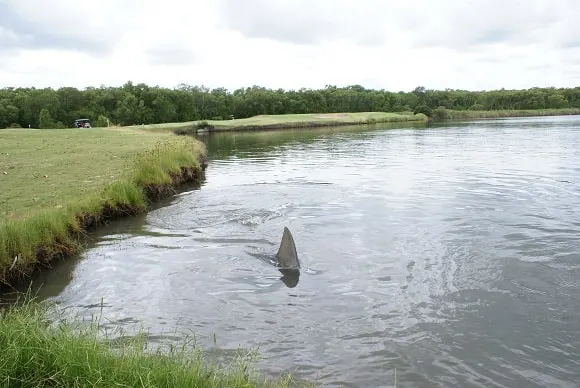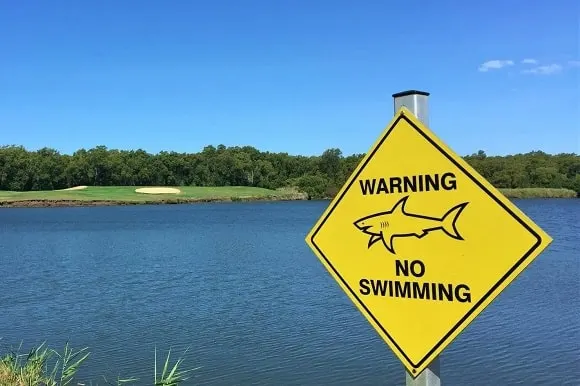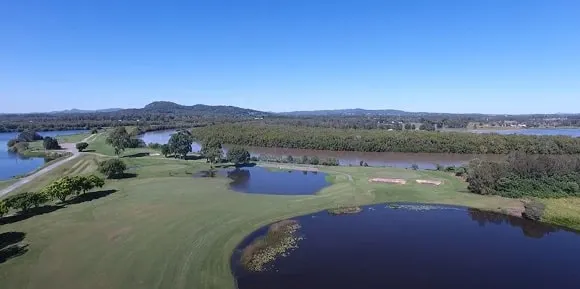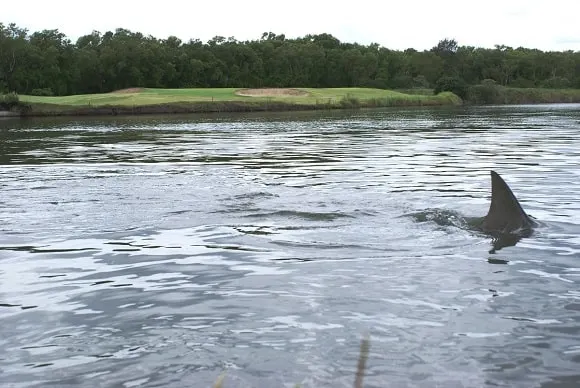Brisbane, Australia – In a bizarre twist of nature, Carbrook Golf Club near Brisbane, Australia, became the ultimate water hazard for golfers, hosting a lake teeming with bull sharks for nearly two decades!
The story began in 1996 when floods from the nearby Logan River swept six young bull sharks into a 51-acre, 50-foot-deep lake near the golf course’s 14th hole.
The sharks, unable to leave when the floodwaters receded, made the lake their home, much to the fascination of golfers and scientists alike.
A Shark Story Like No Other

The bull sharks spent at least 17 years in the lake, sustaining themselves on the abundant fish stock and occasional meat treats the club’s staff provided.
During this time, one of the sharks was illegally fished out. The others vanished after subsequent floods occurred back in 2013, which suggests that they might have been washed out of the lake and possibly returned to a river or the sea.
The presence of these sharks wasn’t just a fluke; it demonstrated the adaptability of bull sharks to live in low-salinity aquatic environments over a very long period of time.
This adaptability allows them to venture into freshwater and brackish habitats such as rivers, estuaries, and lagoons, often bringing them into close quarters with humans.
Reactions from the Fairway

When the first sightings of a fin on the lake began in the early 2000s, the staff and members of Carbrook Golf Club were in for a huge surprise.
Scott Wagstaff, the general manager of Carbrook Golf Club, shared his insights in an interview with The New York Times.
He recalled the initial reactions, saying, “Every single member here just loved the sharks.” The presence of these aquatic predators added a unique charm to the golfing experience.
The club’s members embraced the sharks, seeing them as a unique feature that set Carbrook apart from other golf courses worldwide.
While the idea of sharing a lake with bull sharks might be daunting to some, the golfers at Carbrook relished the opportunity.
The sharks became a part of the club’s identity, a story that members proudly shared with visitors and friends.
I wanted to dig a little deeper, so I contacted Scott Wagstaff, the golf club’s general manager, and asked him a few additional questions about this unique story.
Interview with Scott Wagstaff, General Manager of Carbrook Golf Club
Q: How did you guys find out about the sharks? What were your first thoughts?
A: The sharks came into the lake in one of the flood events in the mid-1990s. The last one was in 1996. Initially, we had no idea about these new inhabitants, and they most likely grew from being small juvenile bull sharks.
In the early 2000s, as they started to grow, there were sightings of a fin on the lake. Initially, these stories were met with skepticism.
But as these stories became more frequent, they were accepted as truth and not just tales from golfers having too many beers during their rounds!
Q: How did your club members react to this over time? From outrage or fear to delight?

A: Our members have always embraced our sharks and loved the fact that Carbrook is unique with this incredible story.
One of the highlights of playing at Carbrook was sighting one of the sharks, especially around the 14th and 15th holes, which are next to what we refer to as Shark Lake.
Q: In what ways did you use the sharks as marketing for your golf course?
A: Initially, we didn’t do much and just enjoyed the sharks as part of our family. However, in 2011, I managed to capture some footage and shared it on YouTube, which garnered global interest.
In 2012, we changed our Club’s logo to incorporate the Shark, which was extremely well-received. We’ve enjoyed the publicity that the sharks have brought without actively marketing them.
Q: How did it feel when the sharks found their way back to the river? And when did that happen?
A: We’ve had several flood events in the past decade, including 2013, 2017, and 2022. This has made it difficult to determine the current shark population in the lake.
We haven’t seen any large sharks for over five years, but recent floods might have brought in some smaller ones. I always advise against swimming in that lake!
Q: How big is the pond, and how big were the sharks? Do you have that information?
A: We know that at least six adult bull sharks were in the lake around 2009. The pond is more of a lake, spanning 51 hectares in surface area with a maximum depth of around 50 feet.
DID YOU KNOW: Adult bull sharks can measure between 7 and 10 feet and weigh between 200 and 400 pounds! (Now imagine that swimming around in a golf course pond)
It’s a man-made lake resulting from sand mining in the 1980s and 1990s. Interestingly, we’re now gaining approval to fill the lake and return it to land for further golf course development.
RELATED ARTICLE: What Is the maximum size of bull sharks?
How Long Can Bull Sharks Live in Freshwater?

Bull sharks are one of the few shark species that can tolerate a wide range of salinities. They have specially adapted kidneys and rectal glands that work together to recycle and retain the salt in their bodies, allowing them to survive in freshwater.
Young bull sharks often use freshwater and brackish habitats as a safe haven to grow up without the threat of predation from larger sharks.
However, once they reach maturity, they usually head to the sea for larger prey and breeding opportunities.
A study published in the Journal of Marine and Fisheries Science by Peter Gausmann, a shark scientist, highlighted the remarkable ability of bull sharks to thrive in such environments.
The research suggested that there is “no upper limit” to how long these sharks can spend in low-salinity environments, shedding light on their longevity and adaptability.
The Carbrook Golf Club sharks provided a unique opportunity for scientists to study this species in a different light.
Related Articles
- How Big Do Great Whites Get?
- What Is the Biggest Tiger Shark Ever Recorded?
- How Big Was “Old Hitler” the Hammerhead Shark?
Featured image courtesy of Scott Wagstaff


Leave a comment